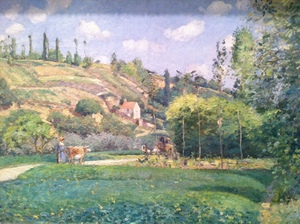Pissarro
Snow
Saturday, February 15, 2014

Camille Pissarro,
Pontoise, the Road to Gisors in Winter,
1873, iphone detail
*
At this time last year, in the days when my father was dying, it snowed and snowed. From the hospital windows, it had its beauty. The hallway near the elevators had windows that looked down on to a sort of large courtyard, not rustic, but still made precise by the snow. People crossed and you would see dark footprints. These would then be covered. The footprints and their being covered, traces of particular steps and shoes, then again white -- the tiny brevity of each passing figure, of the length of time in which the marks each made were visible, and then the snow.
*

*
*

*
Time is slower in the snow. You can see it passing before your eyes. Discrete white that you can follow just long enough to feel that you were following it before it was lost, but over and over so that the seconds fill, and the minutes.
*

*
A man in a blue hat, walking vigorously -- I can see his head and shoulders beyond the fence with its white lines, through the scrim of white air -- passes the stop sign, makes his way along the road, goes behind the pine tree now more white than green, leaves the visual field.




